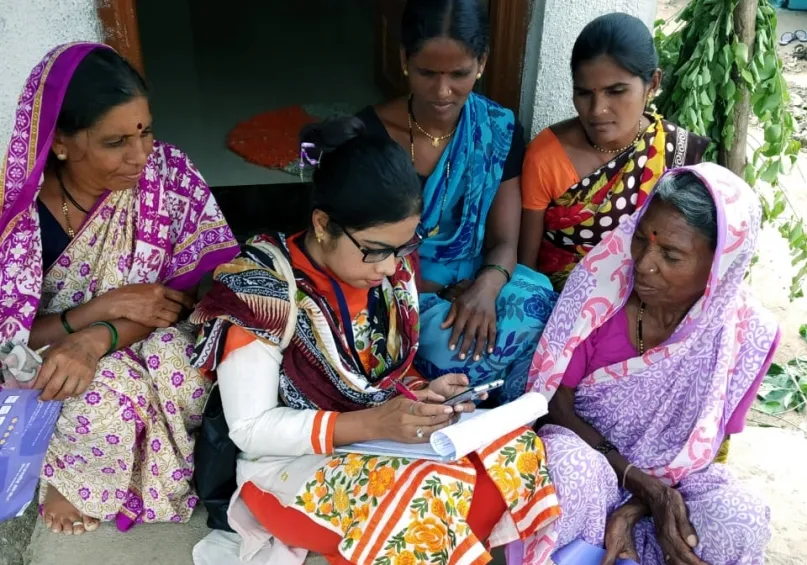Three Steps for Closing India’s Gender Gap in Digital Financial Services

Last month, Sarita took one step closer to financial independence: she learned how to use digital financial products at a training session in her district of Nagpur in the Indian state of Maharashtra. Though she owned a basic mobile phone, she had never used it for a financial transaction. But with the nearest bank 10 kilometers away from her village, and no easy way to get there, Sarita was excited by the idea of using digital services to bank right from her doorstep. She was also circumspect. “I don’t have a smartphone and don’t know how to operate one. Also, I have heard from a few villagers that their money got stuck for more than 15 days due to a failed transaction,” she said.
The challenge of the digital gender divide
Sarita’s experience underscores the challenge of closing the financial inclusion gender gap using digital financial services (DFS). Although they can deliver low-cost services and mitigate barriers related to identification, cost and mobility, digital financial services are unfamiliar to many low-income women in India. Therefore, to close the financial inclusion gender gap, we must first close the digital gender divide by:
- Improving women’s digital literacy.
- Increasing their mobile ownership.
- Providing products tailored to the needs of low-income women.
Although India outpaces countries such as Bangladesh, Indonesia and Nigeria in connecting women to formal financial services, women still trail men in access to bank accounts by 6 percentage points, and in usage by 11 percentage points. Indeed, only 46 percent of women compared to 57 percent of men in the country use their bank accounts at all. The digital divide is also gaping. A BCG study in 2015 found that the share of women Internet users in urban areas of India was only 29 percent. The gender gap in mobile ownership is estimated to be as high as 19 percent.
Zooming in on Sarita’s district, the baseline study for our DIvE project (Digital Inclusion via Education) in Nagpur showed that awareness of digital financial services was low among women in both rural and urban areas, and that the gender gap in account ownership stood at 12 percentage points, double the national level. We also found large gender gaps in mobile ownership (27 percentage points) and smartphone ownership (22 percentage points). Furthermore, only 9 percent of women respondents had used mobile for any financial transaction, compared to 16 percent of men.
Interestingly, although there was a 24 percentage point gender gap in debit card ownership, for those with a debit card, 74 percent of the women had used it in the last six months compared to 72 percent of the men. In fact, the study suggested that access coupled with awareness of the digital financial products resulted in higher uptake among women than men.
Initiatives working to bridge the gap
While to-date initiatives have resulted primarily in extending access to financial services, especially in regions not reached by traditional bank branches, we must now work to increase usage through knowledgeable use of digital financial services.
Grameen Foundation for Social Impact is addressing the challenge of deepening digital financial literacy in Nagpur through a targeted program for low-income women and youth called DIvE. Funded by CitiCorp Finance India Limited and Citigroup Global Markets India Private Limited, the program aims to train 250,000 clients on four DFS products offered by the government: Aadhar Enabled Payment System (AePS), Unstructured Supplementary Service Data (USSD)/Bharat Interface for Money (BHIM), Unified Payments Interface (UPI) and the Rupay Card.
These products offer basic banking services to the customers at their doorsteps, such as balance enquiry, fund transfer and mini statements. AePS and the Rupay card also enable cash withdrawal and deposit at points of sale.
DIvE has adopted a novel approach for generating awareness and behavior change regarding DFS by including elements to nudge and engage clients for adoption of DFS products. The program adopts a three-touch model: each client is visited at least three times during the program. The first touch includes identifying the needs and suitable products and training on the product. The second touch is a refresher session to understand concerns and address clients’ queries and issues. Both sessions are available either to groups or to individuals. The third touch is a mandatory one-on-one session where Grameen Mitras or trainers work with clients to log into the DFS platform and/or conduct a transaction.
Grameen Mitras, or trainers, are the cornerstone of the project. Unlike traditional trainers, they don’t move on from clients once training has ended. They continue to visit them, helping to build their financial capabilities and adoption of services. They also serve as a banking access point, providing services such as goal-based savings, regular banking transactions and bill payments. In less than a year, the program has reached 160,000 low-income individuals, including 90,000 women and 50,000 youth.
Government and social businesses are also working extensively to bridge the gender digital divide through initiatives such as Sanchar Kranti Yojana, which aims to distribute 5 million smartphones to low-income women in both rural and urban areas. With increased mobile ownership, these women are expected to “go digital” and online in their daily life.
Public as well as private initiatives in India have continued designing innovative financial products for greater uptake among low-income households. Organizations like Kaleidofin, have started offering tailored financial products to these low-income households to cater to their needs and include them meaningfully.
Taken together, these projects can bring the benefits of digital financial services to millions of women across India, through improving their digital literacy, increasing mobile ownership of women and providing tailored solutions for greater uptake. With concentrated efforts in these three areas, women will be equipped to take their financial destinies into their own hands.


